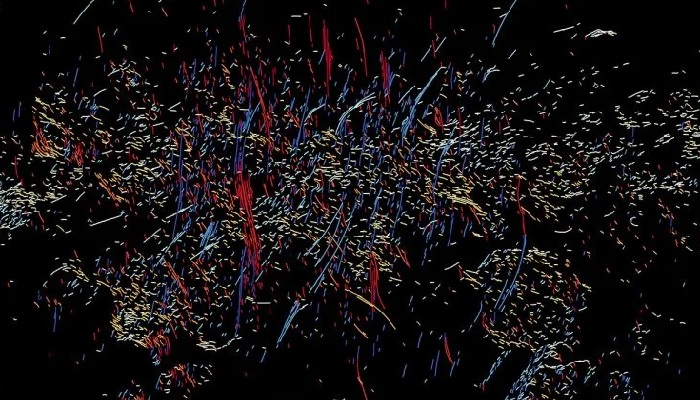Stunned astronomers finally unravel 'colourful cosmic threads' in Milky Way
These filaments likely originated millions of years ago from a supermassive black hole at centre of Milky Way
June 03, 2023

The discovery of a mesmerising array of one-dimensional structures that resemble a vibrant tapestry, stretching across the galactic centre, is intriguing astronomers around the world.
These structures, resembling cosmic threads, have an ethereal quality that is reminiscent of a rainbow.
What makes them even more intriguing is their alignment along a single dimension, giving them a slender and elongated appearance.
What are they by the way?
A team of international astrophysicists has made an extraordinary discovery in the centre of our Milky Way galaxy, as they have found hundreds of mysterious structures known as one-dimensional cosmic threads, CNN reported.
These filaments are slender, elongated bodies of luminous gas that stretch horizontally or radially.
According to a study published in The Astrophysical Journal Letters, these filaments likely originated millions of years ago when the outflow from Sagittarius A*, the supermassive black hole at the centre of the Milky Way, interacted with its surrounding materials.
Each filament measures between 5 and 10 light-years in length, relatively short in cosmic terms.
This discovery comes almost four decades after Farhad Yusef-Zadeh, the lead author of the study, and his colleagues identified another population of vertical one-dimensional filaments near the galactic centre.
These filaments were much larger, spanning up to 150 light-years each. In 2022, Yusef-Zadeh and his collaborators discovered hundreds more paired and clustered vertical filaments in the same area, realizing that they were likely connected to the activity of Sagittarius A* rather than supernova bursts as previously believed.
The latest study builds upon and strengthens these earlier findings.
Yusef-Zadeh expressed surprise at the discovery of this "new population of structures that seem to be pointing in the direction of the black hole."
The team conducted extensive work to ensure the validity of their findings and establish the connection to the black hole's outflow.
Yusef-Zadeh stated that these filaments are not random but appear to be tied to the outflow of Sagittarius A*, bringing order to the chaotic field of the galaxy's nucleus.
Erika Hamden, an assistant professor of astronomy at the University of Arizona who was not involved in the study, described the findings as "really exciting" and a testament to the beauty of the universe.
She noted that Sagittarius A* is the closest supermassive black hole to us, but its relative quietness makes it challenging to study.
However, this work provides evidence of recent energetic outflows from the black hole in the form of a jet and conical outflow.
The structures were detected by analysing images obtained from the South African Radio Astronomy Observatory's MeerKAT telescope.
This groundbreaking instrument, consisting of 64 satellite dishes standing 65 feet tall each, is connected across a 5-mile expanse in a sparsely populated area, minimizing interference. Yusef-Zadeh praised the MeerKAT observations as a game-changer and a significant technical achievement for radio astronomers.
Although the newly discovered filaments share similarities with those identified in 1984, the authors of the study believe there are distinct differences between the two populations.
The vertical filaments are located perpendicular to the galactic plane, while the horizontal filaments run parallel to the plane and point radially towards the black hole.
The vertical filaments surround the Milky Way's nucleus, while the horizontal ones appear to spread out towards one side, reaching towards the black hole.
The behaviour of these filaments also differs. The horizontal filaments emit thermal radiation and contain material associated with molecular clouds that are partially or fully embedded in the outflow from the black hole.
On the other hand, the vertical filaments are magnetic and house cosmic ray electrons moving at speeds close to that of light.
The authors believe that further study of these newfound filaments could provide insights into the black hole's spin and the orientation of its accretion disk.
The accretion disk is a thin, hot structure formed when material from a nearby star orbits the black hole in a circular path.
Additional research is needed to determine if the jet-driven outflow from the black hole, and therefore more filaments, appear on both sides.









